Constructing a New Cricket Square
The village of North Curry is situated six miles east of Taunton in Somerset. With a population of around 1600, it is a typical English village with the usual amenities. All except, that is, a cricket ground.
In 1998, the idea was born to find a location in the village to build a sports ground to accommodate both the football and cricket clubs (the football club currently resides on a small playing field in the centre of the village with a small pitch and inadequate changing facilities).
The site identified was agricultural land outside the development belt within the village but, after being recommended for refusal by Taunton Deane Borough Council, a one vote margin at the planning meeting in October 2006 saw permission granted for a housing developer to construct five open market houses and three low cost houses for local people, and the sports ground under Section 106 (S106) of the Town and Country Planning Act 1990.
S106 agreements are a way of delivering or addressing matters that are necessary to make a development acceptable in planning terms. They are increasingly used to support the provision of services and infrastructure, such as highways, recreational facilities, education, health and affordable housing.
The land was bought by the developer from a trust and then given to the parish for use as recreational land only. As part of the S106 agreement, the developer had to deliver a functional sports ground with changing facilities, car park and all services.
Using the opportunity, the parish council formed a sub committee to look into obtaining a grant for enhanced facilities to be built. The only body that looked likely to fund our facility was The Football Foundation, so work to build a portfolio and application began in January 2007, with submission in March 2008.
A huge amount of research, volunteer time and effort went into the application, including agronomy reports (carried out by Gordon Jaaback), financial plans, business plans, development plans and proof of the need for the facilities in the area, etc. The initial application was turned down, but we received a smaller grant of £16,000 to develop football in the area.
As part of the grant bid, the changing facilities had to meet the specifications of the Football Foundation, so the pavilion we had built was huge and to a very high standard.
Because the initial bid was rejected – it has to be said that the local FA had led us up the garden path somewhat! – the majority of the money committed by the developer was tied up in the pavilion. Consequently, the pitches were constructed to a lower specification than was desired. It also meant there wasn’t enough money to construct the cricket square.
So, the cricket club raised the money themselves (£15k) to do this and to realise the dream of playing cricket in their own village!
The developer completed the building of the houses in May 2008 and the pavilion in June 2008. We also managed to squeeze a machinery garage out of him as well!
The pitches were constructed in October and November 2008 by a contractor chosen by the developer – now, consequently, at a much lower specification. But, of course, this was now out of the parish council’s hands.
The old grassland was sprayed off, turned over and then the topsoil was stripped off and stockpiled. The sub soil was then graded, drainage installed and the topsoil replaced. 100mm drainage pipes were laid at 15 metre centres across the whole field. Drainage was to a perimeter ditch leading down to a pond in the northern corner of the site. The area was then power harrowed, stone buried and levelled before seeding and fertilising took place, and then rolled.
We could only watch in disbelief as this work was carried out during pretty wet conditions so late in the year and, although we tried to get the work put off until the spring, the developer just wanted to get off the site and ploughed ahead with the work regardless. As part of the S106 agreement, he couldn’t sell his last house until the sports ground was completed, so we could see his reasons for wanting to get it done!
Although the grass did eventually germinate, only a 40-50% coverage was evident, and a huge amount of stones reappeared on top over the course of the winter. As spring came, the levels became dreadful with wavy ruts, as deep as 150mm in places, all over the site.
The parish council were furious and demanded the developer re-do the site as it was clearly not fit for purpose. They, and the contractor he used, did eventually agree to do the whole site again. They even admitted it was a poor job and that, in hindsight, he should have just walked away rather than carry out the job in November – at least he was honest! He said that he did not want his name to be associated with such a bad job.
So, at the developer’s own cost, the whole site was turned over again to 300mm and regraded, power harrowed, stone buried, seeded, fertilised and rolled in May 2009.
The results were a thousand times better as the mixed weather brought rapid germination of the grass seed and a healthy sward within a few weeks. Also, the ground was now level and not rutted! After four initial cuts with outfront rotary mowers, using another contractor, the cricket club acquired a tractor and trailed gang mowers and started their own cutting in August 2009.
The site was finally handed over to the parish council in September 2009, the same week that construction of the square was completed.
It is planned for the football club to start using the facilities in August 2010 and the cricket club in April 2011.
Despite the ground not being used at the moment for sports, there have been a couple of fund raising events so far, including a marquee with band and hog roast, and a small arboretum has been planted to encourage walkers to use the site. Further plans include another hog roast, a trim trail, more tree planting and planning permission for three hard tennis courts as part of future developments. The pavilion will also be utilised for events.
So, despite all the ups and downs, it seems that North Curry have finally got their new sports ground, and one that they can certainly be proud of!
Constructing the square
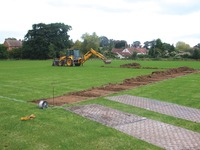 The cricket square was constructed over eight days at the end of September 2009. I drew up a schedule of works, and materials and machinery were ordered/booked during August.
The cricket square was constructed over eight days at the end of September 2009. I drew up a schedule of works, and materials and machinery were ordered/booked during August.
A local JCB contractor (who I’ve used before at the school) was booked in as well. I have shown the actual timeline of events which, as it turned out, was very tight!
Apart from the JCB contractor, all labour was volunteer (mainly cricket club members, but with some villagers helping out) and, therefore, free. There was a real community spirit amongst all those who helped out and, despite it being very hard work with long hours, it was great fun and a huge level of satisfaction and achievement was felt by all.
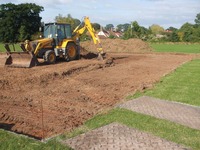 The gravel and sand were tested for bridging capabilities, permeability and uniformity, and the existing native top soil for compatibility with the imported GOSTD 125 cricket loam from Surrey Loams Ltd.
The gravel and sand were tested for bridging capabilities, permeability and uniformity, and the existing native top soil for compatibility with the imported GOSTD 125 cricket loam from Surrey Loams Ltd.
Having never built a cricket square before, it was quiet stressful as the amount of money involved was significant – and it wasn’t my money! I was also worrying about the weather and if everything would go to plan. It certainly paid dividends to consult with people who have had experience of constructing squares before and using the internet for additional advice.
It didn’t go exactly as planned as I felt there was too much guesswork for my liking during construction. But, overall, I was satisfied with the end product, as were the cricket club, and we came in just under budget.
I did feel that we came up a little short on the final levels, as the square isn’t as proud from the surrounding outfield level as I would have liked. However, with the budget available, it was never going to be the best, or most accurate construction project. It does show though what can be achieved on a tight budget, without all the proper machinery using inexperienced, volunteer labour!
Schedule of works
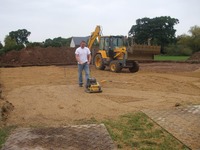 Dimensions: 23.2 x 24.4m (566.08m2).
Dimensions: 23.2 x 24.4m (566.08m2).
Existing land drains: 600mm deep, 15m spacings, 80mm diameter.
Gravel: Sherriff Amenity: 6mm gravel – £24.00/tonne + VAT (100 tonnes) = £2760.00 – ordered 20/08/09 for delivery Thursday 17th September/Friday 18th September.
Sand: Sherriff Amenity: AFS50 sand – £27.50/tonne + VAT (40 tonnes) = £1265.00 – ordered 20/08/09 for delivery Friday 18th September.
Loam: Surrey Loams Ltd: Rigid lorry delivery: £88 + VAT per cubic metre delivered. GOSTD 125 loam 75 cubic metres @ £101.20 = £7590.00 – ordered 19/08/09 for delivery Monday 21st and Tuesday 22nd September.
Drainage pipe: 80mm diameter pipe, 100 metres coil = £75.40 + VAT = £86.71. Carriage @ £15 + VAT = £17.25 – ordered 02/09/09. Delivered 04/09/09. 80mm connectors x2 @ £3.75 each + VAT = £8.63 – ordered 02/09/09. Delivered 04/09/09.
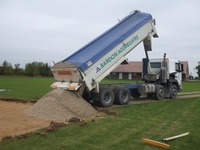 Seed: Advanta MM50 (square) – 2x20kg bags @ £108.60 = £217.20
Seed: Advanta MM50 (square) – 2x20kg bags @ £108.60 = £217.20
Advanta MM25 (outfield) -1x20kg bag @ £100.32 = £100.32. Ordered 19/08/09. Delivered 24/08/09.
Fertiliser: Pre-seeding fertiliser Evolution 6:9:6 – 1x25kg bag @ £24.62 + VAT = £28.31. Ordered 19/08/09. Delivered 03/09/09.
Hire: Wacker plate (Eagle Plant) = £20 + £24 delivery & collection + VAT = £50.60*. Booked 19/08/09 for hire Friday 18th September.
*Hire of second, smaller wacker plate = £18 + £12 delivery + VAT = £34.50
Ground guards (x33) = £473 inc. delivery & collection + VAT = £543.95. Booked 04/09/09 for delivery Wednesday 16th September.
JCB + operator: (Philip Palfrey) @ £20 per hour + VAT (£23/hr) = £1104.00* (see below). Booked 19/08/09 for 16, 17, 18, 19, 21, 22 September (for 48 hours work over 6 days).
Laser level (Philip Palfrey) – included in above costing
*Actual hours = 58.5 including 6 hours on Wednesday 23rd Sept. Actual cost = £1645.50 inc. Includes last minute dumper truck hire.
Transportation of tractor, seeder, scarifier and topdresser (Lee Holmes) = no cost. Booked 04/09/09 (to North Curry Friday 18th September, 8am, returning Wednesday 23rd September, 12pm).
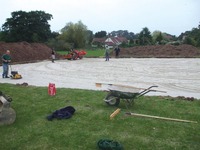 Borrow:
Borrow:
Kubota tractor/loader (all Taunton School) *£21.20 to refuel tractor
Variseeder
Sisis scarifier
Fertiliser spreader
Shovels x2
Metal dragmat
Measuring wheel, 100m tape measure, string line, pegs, aerosol paint
Aluminium ladder on ropes (from home)
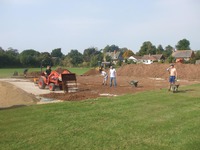 Purchase:
Purchase:
Orange fencing (for 100 metres) 04/09/09.
Metal stakes x20 04/09/09.
Chelwood rakes x6 28/08/09.
Shovels x2 04/09/09.
Tarpaulins (enough to cover 40 tonnes of material, base and top) 10x4mx4. 04/09/09.
Total cost: £386.85
Labour: All voluntary. Organise volunteers two weeks before start date. Emails sent out 28/08/09. Reminder emails sent out 11/09/09 with rotas.
Proposed Timeline:
Week before, inform all neighbours in Morris Way of lorry movements. Done by letter delivered Monday 14th – see below.
Monday 14th September – Locate and mark out square, including perimeter drain.
Tuesday 15th September – Transport ground guards from Taunton School to the site at White Street, North Curry.
Wednesday 16th September – Locate water point. Excavate square and perimeter drain with outfall (to locate existing land drain). Remaining hired in ground guards delivered.
Thursday 17th September – Import and spread gravel, inserting perimeter drain.
Hired in wacker plate to be delivered.
Friday 18th September – Import and spread coarse sand layer. Start replacing native soil. Off hire wacker plate.
Saturday 19th September – Continue replacing native soil.
Sunday 20th September – Reserve day.
Monday 21st September – Import GOSTD loam (at two hour intervals).
Tuesday 22nd September – Import remaining loam (two hour intervals). Off hire ground guards. Seed and fertilise. Make good surrounds and lorry tracks, etc. Fence off and clear site.
Actual timeline of events
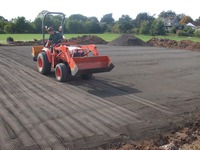 Tuesday 8th September – On-site meeting held with Philip Palfrey, the project JCB contractor, to discuss plans of work and to give paperwork.
Tuesday 8th September – On-site meeting held with Philip Palfrey, the project JCB contractor, to discuss plans of work and to give paperwork.
Monday 14th September – Square location measured out and orientated. 8 pitch square 23.2m x 24.4m (566m2) – for the desired side on view from the pavilion, the orientation isn’t exactly N-S but 50 degrees towards NW, which is within the ECB recommended guidelines of 55 degrees variation either side of N-S. Letters to notify residents delivered.
Tuesday 15th September – Grounds guards transported from Taunton School to site early evening. Measured out and marked lorry track width (2.6m between outside edges of wheels) from edge of square to car park and laid down guards accordingly.
Wednesday 16th September – 8am: JCB contractor arrives on site. Strips off turf from square and forms heap adjacent to square away from delivery area. JCB then begins excavation to formation level – 325mm (13″). Topsoil is stockpiled adjacent to square at the back away from delivery area. Approximately two thirds of the square is excavated by the end of the day. Laser level is not used due to slope of square – unfortunately, this is dictated by the outfield fall levels. Drop is approximately 1:35 across square (about 700mm). Hired in ground guards arrive in the afternoon and are laid to form track way to square for deliveries. In all, 54 ground guards are being used to cover a track 65 metres in length. We are actually about five metres short, so the grass nearest the car park is left uncovered.
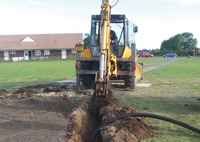 Thursday 17th September – Continued to excavate native top soil as first gravel deliveries arrive at 8.00am (two lorry loads). Excavation complete by around 10.00am. JCB used to spread gravel around excavated area. One more lorry load of gravel delivered at 1.00pm and the final two together at 3.00pm. Begin spreading gravel to 100mm (4″) depth across whole site using marks on ends of rakes to gauge depth accuracy. Delivery of two wacker plates meant we started compacting gravel. Breakdown of JCB lost 3.5 hours work. Phoned suppliers to put back sand delivery to Friday after 1.00pm.
Thursday 17th September – Continued to excavate native top soil as first gravel deliveries arrive at 8.00am (two lorry loads). Excavation complete by around 10.00am. JCB used to spread gravel around excavated area. One more lorry load of gravel delivered at 1.00pm and the final two together at 3.00pm. Begin spreading gravel to 100mm (4″) depth across whole site using marks on ends of rakes to gauge depth accuracy. Delivery of two wacker plates meant we started compacting gravel. Breakdown of JCB lost 3.5 hours work. Phoned suppliers to put back sand delivery to Friday after 1.00pm.
Friday 18th September – Continued to level out and compact gravel. Approximately 12 tonnes of gravel stockpiled by square for use in perimeter drain later on. Completed gravel consolidation by 2.00pm. Two lorry loads of AFS50 coarse sand delivered together at 2.30pm. Spread (with help from JCB), raked and compacted (wacker plate) sand to 50mm depth across whole area. Completed by 7.45pm. Delivery of loan machinery from Taunton School by 2.00pm.
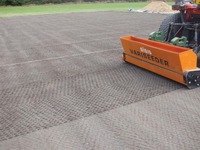 Saturday 19th September – Commenced returning native soil into square using compact tractor with loader, and lots of manpower with rakes and wheelbarrows. Native soil very dry and lumpy with stones. Large lumps and stones removed by hand and stock piled separately. Layers tracked in using compact tractor. JCB contractor excavates three net bases alongside machinery shed and starts to shift soil/ripped turf to boundary edges. Contractor’s dumper truck hired in.
Saturday 19th September – Commenced returning native soil into square using compact tractor with loader, and lots of manpower with rakes and wheelbarrows. Native soil very dry and lumpy with stones. Large lumps and stones removed by hand and stock piled separately. Layers tracked in using compact tractor. JCB contractor excavates three net bases alongside machinery shed and starts to shift soil/ripped turf to boundary edges. Contractor’s dumper truck hired in.
Sunday 20th September – Reserve day used to continue returning native top soil to square as above. Five layers were achieved in total. On final layer, string lines across square were used every two metres to check levels after tracking-in. Measurements taken all along each line and infill/removal of soil carried out until satisfactory levels attained across site. Remaining depth was between 60-90mm (2.5-3.5″). Scarifier used to form key to accept loam. No contractor in today.
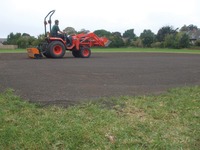 Monday 21st September – Finished off attaining final levels of native top soil by 9am. First two lorry loads from Surrey Loams Ltd of their GOSTD 125 cricket loam arrive at 9.30am. JCB contractor begins excavation of perimeter drain @ 500mm using 300mm wide bucket. Later in the day, we would find water point with the JCB digging the perimeter drain – cue fountain! Water supply turned off until pipe is capped later on. Using compact tractor with loader, begin spreading loam across square in heaps and raking to approximately 20mm (3/4″) depth. Once square area was covered, compact tractor was used to consolidate the loam. Each tracking-in took approximately 75 minutes, going at a slow walking pace moving over one wheel track at a time. To form a key for each new layer, the Variseeder on the back of the tractor was used to spike holes. Third loam delivery arrived at 3.00pm. Two layers tracked-in achieved by end of day, with about a third of third load remaining. Perimeter drain also installed and connected up to land drain, and all back filled with remaining gravel and native top soil by end of the day.
Monday 21st September – Finished off attaining final levels of native top soil by 9am. First two lorry loads from Surrey Loams Ltd of their GOSTD 125 cricket loam arrive at 9.30am. JCB contractor begins excavation of perimeter drain @ 500mm using 300mm wide bucket. Later in the day, we would find water point with the JCB digging the perimeter drain – cue fountain! Water supply turned off until pipe is capped later on. Using compact tractor with loader, begin spreading loam across square in heaps and raking to approximately 20mm (3/4″) depth. Once square area was covered, compact tractor was used to consolidate the loam. Each tracking-in took approximately 75 minutes, going at a slow walking pace moving over one wheel track at a time. To form a key for each new layer, the Variseeder on the back of the tractor was used to spike holes. Third loam delivery arrived at 3.00pm. Two layers tracked-in achieved by end of day, with about a third of third load remaining. Perimeter drain also installed and connected up to land drain, and all back filled with remaining gravel and native top soil by end of the day.
Meanwhile, the excess topsoil, was moved using the JCB and dumper truck to create low, 600mm (2ft) banks around the perimeter of the boundary to help prevent future ball loss in the surrounding undergrowth. Also, a viewing bank in front of the pavilion was created.
Tuesday 22nd September – Final two lorry loads of GOSTD 125 cricket loam arrive on site at 9.30am. Loam spread as above but, this time, an aluminium ladder was pulled across each layer before tracking in. This levelled the loam by pulling material into low spots and removing it from high spots.
After running string lines across the square, as per native topsoil, we locally shifted loam from high spots to low spots using a manual lute, raking in locally and then did a final tracking-in session to complete the square. The rest of the native topsoil was moved to outside the front of the pavilion and sculpted to create a level area to be a future grassed viewing feature. Ground guards were off-hired after the final deliveries.
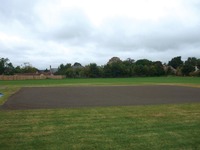 Wednesday 23rd September – Ground guards picked up at 8.00am. Started to do another track across the square, but it started to drizzle lightly. So, the square was seeded in three directions, at acute angles to each pass, with Advanta MM50 seed with pure ryegrass at 50gm/m2. This was done using the tractor mounted Variseeder. The square was then dragmatted to help bury the seed and then fertilised with a 6:9:6 pre-seeding fertiliser at 35gm/m2.
Wednesday 23rd September – Ground guards picked up at 8.00am. Started to do another track across the square, but it started to drizzle lightly. So, the square was seeded in three directions, at acute angles to each pass, with Advanta MM50 seed with pure ryegrass at 50gm/m2. This was done using the tractor mounted Variseeder. The square was then dragmatted to help bury the seed and then fertilised with a 6:9:6 pre-seeding fertiliser at 35gm/m2.
Finally, the square was fenced off with builders orange mesh and metal stakes to protect it from animals and human traffic. The JCB contractor spent a final half day levelling off the top of the banking around the perimeter and the viewing area outside the pavilion. Loan machinery from Taunton School picked up at 1.00pm.
Jobs left to do: Return ground guards to Taunton School. Rake around outside of square (about 10 metres out) to pick up lumps and stones. Infill scars in surrounds with native topsoil and seed. Seed newly created banks around perimeter of field. Cultivate to tilth and seed newly created viewing bank in front of pavilion. Complete construction of net bases.
Observations:
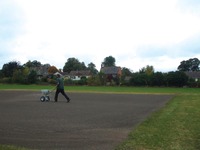 Excavation took much longer than expected – 11/2 days in total. This was due, in part, to the grass being only four months old, it had not really formed into turf but more straggly, rooty individual grasses. This made it more difficult and slower to separate from the topsoil we needed to save. This also meant that the perimeter drain didn’t go in during the initial excavation stage, when it should have, because of the time constraints of the deliveries.
Excavation took much longer than expected – 11/2 days in total. This was due, in part, to the grass being only four months old, it had not really formed into turf but more straggly, rooty individual grasses. This made it more difficult and slower to separate from the topsoil we needed to save. This also meant that the perimeter drain didn’t go in during the initial excavation stage, when it should have, because of the time constraints of the deliveries.
Re-using the native soil, although a good idea – it was tested and found to be compatible with Surrey Loams Ltd’s GOSTD 125 loam – was, in fact, a nightmare to put back because it was very dry, the hard clods not breaking up and the amount of stones. This all had to be separated out manually and it took what seemed forever! It was worth it in the end though as it saved a lot of money over having new soil imported. This also demonstrated the importance of having a reserve/contingency day.
A more detailed meeting with the contractor, prior to commencement of works, would have been beneficial whilst on site to nail down expected timings of work.
When calculating hours of work from a contractor, remember to include their travelling time to and from site.
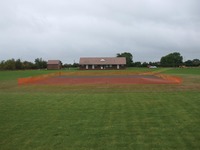 When organising volunteer labour, make sure, in advance, that numbers are spread out over all the days and not have twelve people one day, then three the next!
When organising volunteer labour, make sure, in advance, that numbers are spread out over all the days and not have twelve people one day, then three the next!
Due to the fact that we couldn’t use a laser level for the square because of the slope (we weren’t actually creating a perfectly level square), accuracy of excavation to the formation level was more guesswork. Also, the levels of the various materials being reintroduced were also not accurate. Consequently, we found that we were probably about 10 cubic metres short of GOSTD 125 loam to get the levels above the surrounding outfield. This is not to say that we got the quantities wrong (it was based on 9 cubic metres per pitch). In hindsight, we could have put more of the native soil back to compensate. This is probably where we fell short due to the time it took to get the native soil back in, and the pressure of the imminent arrival of the deliveries.
Finally, thank God for the dry weather! The one thing I can be extremely thankful for is the dry weather we experienced over the whole eight days! Make sure you look hard at the weather forecast in the run up to this type of work – use as many forecast sites online as possible! If there is inclement weather on the horizon, tell suppliers what you are trying to achieve and what difficulties you will encounter if the weather turns against you – warn them about possible last minute changes of plan regarding deliveries.
Total cost of the whole project = £14,756.02
White Street Cricket Square Construction
15th September 2009
Dear Resident,
On behalf of North Curry Cricket Club, I wish to inform you about the construction of the new cricket square on the sports ground.
This will involve increased traffic movements along Morris Way over the period detailed below and will include about 12 large (rigid axle) lorries delivering substantial quantities of materials.
General traffic movement will be during the working day and at the weekend.
Deliveries by lorry will be during the working day but NO deliveries will take place over the weekend.
Please could I ask you to try to avoid leaving vehicles in the road on the Thursday, Friday, Monday & Tuesday during working hours so that the lorries can gain easy access.
I apologise in advance for any inconvenience this may cause.
The dates concerned are:
Thursday 17th September
Friday 18th September
Saturday 19th September
Sunday 20th September
Monday 21st September
Tuesday 22nd September
Building of the square is a one off event and I hope you will agree is for a worthwhile cause.
I thank you for your cooperation and understanding. If you have any concerns or queries then please do not hesitate to contact me on the number below.
Kind regards,
Mark Jolliffe – on behalf of North Curry Cricket Club.
